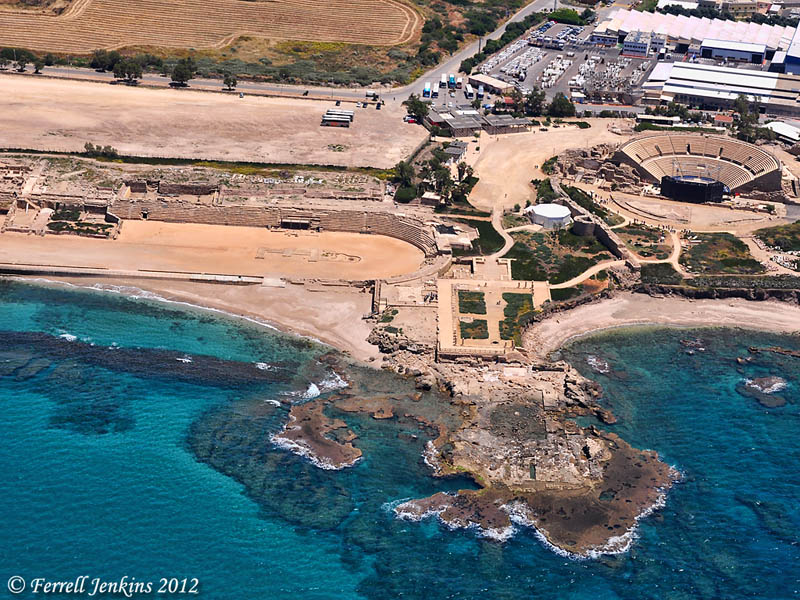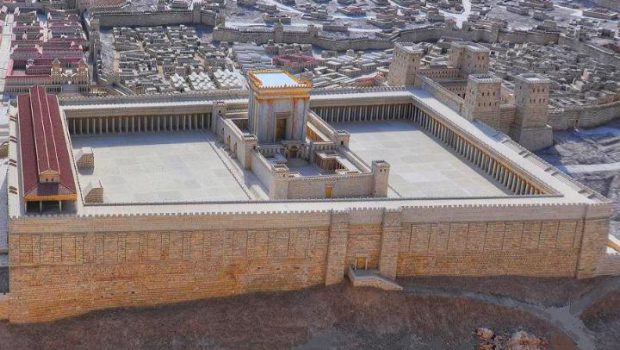Holy Week: Cleansing the Temple
Jesus was a rabbi. One of the most widely used teaching techniques of rabbis is called remez (which roughly translates to “hint”). This rhetorical technique is employed when a teacher uses a word or a phrase to hints at a greater point without stating said point. In rabbinical tradition, this technique has been with regard to Scripture. For instance, a rabbi would quote part of a passage assuming that their audience’s knowledge of the passage would allow them to deduce the fuller meaning. Therefore, listening to a rabbi, Jesus included, would necessitate memorization of large swaths of the Old Testament because they often weren’t going to explicitly say what they wanted to say, but rather hint at it. This technique is still used today and is largely effective for two reasons. First, by hinting at the truth, a teacher forces their audience to work for the conclusion causing them to remember. Secondly, the more the audience knew what was behind the phrase implemented, the more meaning the teaching had. This means an educated audience understood the depths of a particular message far better than an uneducated one. Allow me give you some examples.
If your pastor got up on Sunday and said, “I have some pearls to cast this morning,” you should be taken aback. Why? He just implied that you are swine (Mt. 7:6). Notice, he didn’t call you swine outright, but your knowledge of the passage referenced filled in what he was implying.
Here’s a more difficult example. There was once a professor and lecturer who spent his entire career using the Dead Sea Scrolls to prove that the Bible is accurate and consistent. He trained his students in this manner, but two of them became very prominent dissenters using the Dead Sea Scrolls to teach that the Bible isn’t accurate or consistent. Someone once asked him how he felt about this. He answered saying, “These are the children I have raised and brought up.” Did you catch the remez? Maybe not because we don’t know Isaiah 1:2 that well. If we did, we would see that he has quoted the first portion while intentionally leaving off the last part of the verse. “Children have I reared and brought up, but they have rebelled against me.” By doing this, that teacher gave as scathing a rebuke to his students as he could.
Jesus used this technique quite often and masterfully. Many of the encounters Jesus had with the religious people of the day involved remezim. Let’s look at two examples that occur in the Temple during of Jesus’ final week. The first occurred on Sunday after his entry into the city. The second occurred on Monday, the following day.
Matthew 21:15-16. Jesus’ first Temple remez of Holy Week. Jesus is healing in the Temple and children are dancing around him singing songs. The chief priests, the Sadducees, were angry and told Jesus to make them stop. And Jesus says, “Haven’t you read…” and he quotes Psalm 8:2. Notice, however, that he leaves off the last part of the verse. Psalm 8:2 says, “Out of the mouth of babies and infants, you have established strength against your enemies, to silence the foe and the avenger.” Using remez, Jesus is directly implying that the priests are the enemies of God that will be silenced! In remez, it’s not what Jesus says that is his main point, but it’s the context out of which he takes what he says that is his main point.
__________________________________________________________________________________________________________
Much like the Pharisees and Zealots, the Sadducees and the Essenes were one sect that splintered around the same time (and for largely the same reason) as the hasidim. Hellenism. Prior to the split, the Sadducees and the Essens were known as the Temple party. Most of them were Levitical priests which meant this group was fairly small. They all worked in the Temple and made sure it functioned according to the Torah. While responding to Hellenism tore the hasidim apart, Hellenism itself tore the Temple party apart.

Caesarea Maritima. Ruins of Herod’s palace (center), a Roman arena (The Hippodrome, left), and a theatre (right). Sadducees would have frequented places like these.
The minority, the Sadducees, fell in love with the Greco-Roman lifestyle of leisure, pleasure, theatre, gymnasium, etc. and became overwhelmingly Hellenistic. At one point, so many Sadducees were in the arena watching wrestling matches on the Sabbath that they couldn’t hold the evening worship service at the Temple (2 Maccabees 4:13-15). But the Sadducees were a small minority. Majority of the priests, the Essenes, left Jerusalem believing that God had left as well. They founded a new community near the Dead Sea. There, they studied and copied the Old Testament and waited for God’s hand of judgement come down on the Sadducees, the apostate and evil preists. The Essenes believed that when the Messiah came, he would drive out the evil priests, cleanse the Temple (Malachi 3:1-4), and replace the evil priests with them, the righteous priests.
After the Essenes left Jerusalem, the Sadducees were the only remaining Temple party and were left in charge of the Temple’s functions. This gave them enormous power though they were by far the smallest sect of Judaism at the time. They were, without question, the most powerful in part because they ran the religious system of the day, but also because they were very wealthy. They owed majority of this enormous wealth to Roman support. The Romans saw the Sadducees as puppets that they could use to control the Judean people, particularly through the Sanhedrin, the religious ‘Supreme Court.’ This court was made of up 70 members and was disproportionately stacked with Sadducees (possibly 65 or more).

(CLICK TO ENLARGE) Temple Mount at the time of Jesus. The Royal Colonnade is in the foreground with the Temple in the center.
The Temple mount was Sadducee territory and was composed of several parts. At the southern end was a stoa called The Royal Colonnade. Two important things that occurred there. On the east side of the stoa, the Sanhedrin daily met with other Sadducees to discuss Temple operations. The rest of the stoa was where the animal sacrifices, white garments, incense, and such were bought and sold and where foreign currency was exchanged. Inside the Temple there was an outer area, called the Court of the Gentiles, and inside a low wall, or soreg, were the inner courts. That soreg was put in place to keep Gentiles and non-purified Jews out of the inner courts. Per God’s commandments, the Temple was divided into Gentiles and Jews. If Gentiles crossed the soreg, they would have been killed, so they had to worship from about 200 yards away from the Temple. There were a large number of Gentiles who worshiped God during that time (e.g. the Ethiopian eunuch, Cornelius the Centurion, et. al.). Putting this all in perspective, on the south side of the Temple mount, just behind the Gentile courts, the animal sacrifices were bought and sold.

(CLICK TO ENLARGE) Close up of the inner courts. Note the soreg separating the outer courts from the inner courts.
Just before Jesus began his ministry, the Sadducees, who made money off of the things bought and sold in the stoa, said, “We’re out of room. We have so many pilgrims coming. This stoa is too small for us to conduct business.” What this really meant was, “There’s an opportunity to make more money.” So, they expanded the buying and selling out into the Gentile court of worship. Imagine for a moment that you’re a Gentile who has trekked 500 miles to worship God and when you arrive, you find the place where you’re supposed to worship has been converted into a cattle yard.
__________________________________________________________________________________________________________
Matthew 21:12-3 (cf. Mk. 11:15-19; Lk. 19:45-46; Jn. 2:13-16). Jesus’ second Temple remez of Holy Week. On Monday, Jesus entered the Temple and became righteously angry. So angry, in fact, that he started turning over tables and, with a whip, driving the people away who were buying and selling. While doing that, he said, “It is written…” (This phrase should automatically tip us off to a potential remez.) “My house shall be called a house of prayer, but you have made it a den of robbers.” If that’s all we knew, we might conclude that Jesus’ main point was that people were selling and buying in the Temple dishonestly. While this may be true, and I believe it was (Josephus tells us as much), I don’t think this was Jesus’ main point. I think Jesus, in Sadducee territory, had a very pointed message for those outwardly religious, money hungry, prejudicial “priests.” Let me suggest that what Jesus actually does is present is an incredible remez meaning that what Jesus doesn’t say is actually his main point.
Let’s look at the context of Jesus’ citation. He quoted from two places in the Old Testament and both are extremely significant passages regarding the Temple. The first is from Isaiah 56. The first 8 verses are about God extending His salvation to foreigners, the Gentiles. Here are verses 3-7.
For thus says the LORD: “To the eunuchs who keep my Sabbaths, who choose the things that please me and hold fast my covenant, I will give in my house and within my walls a monument and a name better than sons and daughters; I will give them an everlasting name that shall not be cut off. And the foreigners who join themselves to the LORD, to minister to him, to love the name of the LORD, and to be his servants, everyone who keeps the Sabbath and does not profane it, and holds fast my covenant—these I will bring to my holy mountain, and make them joyful in my house of prayer; their burnt offerings and their sacrifices will be accepted on my altar; for my house shall be called a house of prayer… (and here’s the part Jesus’ leaves off)
…for all peoples.”
Jesus is saying to the Sadducees, “How DARE you! How DARE you take the Gentile courts! How DARE you inhibit these people from worshiping! They worship the same God you do!” And everyone listening would have immediately known that his righteous anger was not just at the dishonesty at the money table, but at falsely pious “priests,” Sadducees, who had the nerve to get in the way of the worship and faith and opportunity to praise God of someone they thought was lower just for a chance to make more money. “How DARE you get in the way of someone’s worship of God,” Jesus said. “How DARE you rob from these people who come from the ends of the earth the opportunity to worship and serve God so you can receive more wealth!”
The second part of his quote is from Jeremiah 7 which is about the religious people of the day falsely trusting that they were forgiven before God based on the fact that the Temple was standing. Here are verses 4-11.
“Do not trust in these deceptive words: ‘This is the temple of the LORD, the temple of the LORD, the temple of the LORD.’ For if you truly amend your ways and your deeds, if you truly execute justice one with another, if you do not oppress the sojourner, the fatherless, or the widow, or shed innocent blood in this place, and if you do not go after other gods to your own harm, then I will let you dwell in this place, in the land that I gave of old to your fathers forever. Behold, you trust in deceptive words to no avail. Will you steal, murder, commit adultery, swear falsely, make offerings to Baal, and go after other gods that you have not known, and then come and stand before me in this house, which is called by my name, and say, ‘We are delivered!’—only to go on doing all these abominations? Has this house, which is called by my name, become a den of robbers in your eyes?”
The priests in Jeremiah’s day trusted in the Temple though they committed abominations. The priests in Jeremiah’s day used the Temple as a place for sinners to hide from their sin rather than confess it. And Jesus directs his answer to Jeremiah’s question at the Sadducees. “YOU have made it a den of robbers by using it to hide your own sin of greed and superiority. YOU are just like your fathers.”
And he turned the place upside down. Literally.

Palestinian shepherd carrying a sheep back to the flock
On this day, as we remember our Messiah’s cleansing of the Temple, his fulfillment of the prophecy of Malachi 3, as we remember his anger and frustration, let us ask ourselves we are using our piety, our religious tradition, our behaviors at home, at work, or anywhere else as a mask for sin. Are we guilty like the Sadducees of using our own comfort or bottom line to intentionally (or unintentionally) get in the way of someone else’s legitimate longing for God? If so, hear clearly Jesus’ condemnation of, “How dare you!” But remember his prayer as he died just a few short days later looking into the faces of those same Sadducees. “Father, forgive them.”
Remember, Almighty God, the Chief Shepherd, came for the broken sheep, the distant sheep, the sheep who are far off. God is the God of the nations and the Sadducees had forgotten. Or maybe they didn’t want to know it in the first place. But Jesus came to remind them, to show them, to tell them. And more than that, he came to make a way for people from every tribe and every tongue and every nation to boldly approach the throne of grace. No soregs. No division of courts. No greedy priests. But a better and truer selfless high priest that offered not a lamb or a goat or a bull, but himself once and for all.











